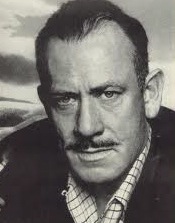This week (July 17-23) in literary history – Erle Stanley
Gardner was born (July 17, 1889); Hunter S. Thompson was born (July 18, 1929); Irish
novelist Frank McCourt died (July 19, 2009); Emile Zola fled France (July 19,
1898); Ernest Hemingway was born (July 21, 1899); J.K. Rowling published Harry Potter and the Deathly Hallows
(July 21, 2007); Shakespeare’s The
Merchant of Venice was entered into the “Stationers Register” (July 22,
1598); Crime novelist Raymond Chandler was born (July 23, 1888)
Highlighted Literary Story
of the Week -
On July 21, 1899, Ernest Miller Hemingway, one of the greatest writers of the 20th century and author of The Sun Also Rises, A Farewell to Arms and other classic works was born in Oak Park,
Illinois. The influential American literary icon who tackled topics such as
bullfighting and war in his work, also became famous for his own macho,
hard-drinking persona.
As a boy, Hemingway, the second of six children of Clarence
Hemingway, a doctor, and Grace Hall Hemingway, a musician, learned to fish and
hunt, which would remain lifelong passions. After graduating from high school
in 1917, he volunteered for the Red Cross as an ambulance driver in Italy
during World War I, he was severely wounded by mortar fire while helping an
injured soldier and spent months recuperating.
After the war, Hemingway returned home and married Hadley
Richardson and the pair moved to Paris, France, and was part of a group of
expatriate writers and artists that included F. Scott Fitzgerald, Gertrude
Stein and Ezra Pound. In 1925, Hemingway published his first collection of
short stories, which was followed by his well-received 1926 debut novel The Sun Also Rises, about a group of
American and British expatriates in the 1920s who journey from Paris to
Pamplona, Spain, to watch bullfighting.
By the late 1920’s, Hemingway published A Farewell to Arms, divorced his first wife and married Pauline
Pfeiffer, left Europe and moved to Key West, Florida. In 1932, his non-fiction
book Death in the Afternoon, about
bullfighting in Spain, was released. It was followed in 1935 by another
non-fiction work, Green Hills of Africa,
about a safari Hemingway made to East Africa in the early 1930s. During the
late 1930s, Hemingway traveled to Spain to report on that country’s civil war,
and also spent time living in Cuba. In 1937, he released To Have and Have Not, a novel about a fishing boat captain forced
to run contraband between Key West and Cuba.
In 1940, the acclaimed For
Whom the Bell Tolls, about a young American fighting with a band of
guerrillas in the Spanish civil war, was published. Hemingway went on to work
as a war correspondent in Europe during World War II, and wrote the 1950 novel Across the River and into the Trees.
Hemingway’s last significant work to be published during his
lifetime was 1952’s The Old Man and the
Sea, a novella about an aging Cuban fisherman that was an allegory
referring to the writer’s own struggles to preserve his art in the face of fame
and attention. Hemingway had become a cult figure whose four marriages and
adventurous exploits in big-game hunting and fishing were widely covered in the
press. But despite his fame, he had not produced a major literary work in the
decade before The Old Man and the Sea
debuted. The book was awarded the Pulitzer Prize in 1953, and Hemingway won the
Nobel Prize for literature in 1954.
After surviving two plane crashes in Africa in 1953,
Hemingway became increasingly anxious and depressed. On July 2, 1961, he killed
himself with a shotgun at his home in Ketchum, Idaho. (His father had committed
suicide in 1928.) He was buried at the Ketchum Cemetery. Three novels were
released posthumously, Islands in the
Stream (1970), The Garden of Eden
(1986) and True at First Light (1999),
as was the memoir A Moveable Feast
(1964), which was about his time in Paris in the 1920s.
Check back every
Friday for a new installment of “This Week in Literary History.”
Michael Thomas Barry is the author of six nonfiction books
that include the award winning Literary Legends
of the British Isles (2012) and America’s
Literary Legends (2014). Visit Michael website www.michaelthomasbarry.com for
more information. His books can be purchased from Amazon through the following links:











